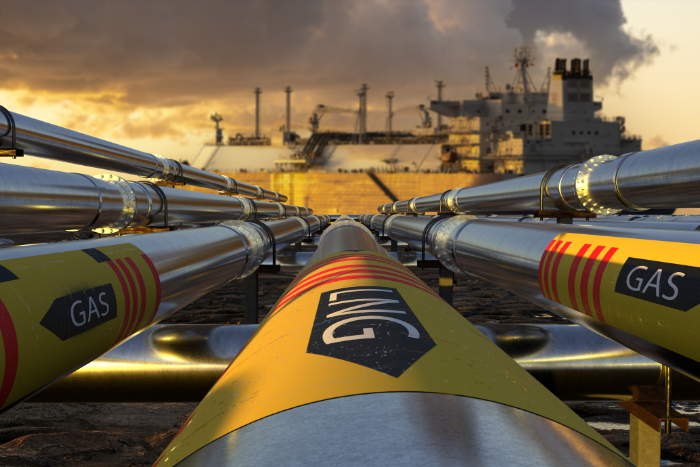Overall, the greenhouse gas footprint for LNG as a fuel source is 33% greater than that for coal, the new study says
Liquefied natural gas (LNG) imported from the United States to Europe and Asia is up to a third more emissions-intensive than coal, a new peer-reviewed paper has found. The study found that LNG imported from the US, the world’s largest exporter, has a larger climate impact than any other fossil fuel—including coal.
Professor Robert W Howarth, the researcher, assessed the lifecycle for the LNG system emissions from the production of shale gas feedstock through combustion by the final consumer, focusing on carbon dioxide and methane emissions at each step along the supply chain. The study compared emissions from LNG to those for coal, along with oil and natural gas used domestically and with that for electric-driven heat pumps.
“Overall, the greenhouse gas footprint for LNG as a fuel source is 33% greater than that for coal,” the study said, when emissions are analysed over a near-term time frame of 20 years (GWP20).
Even considered on the time frame of 100 years after emission, which severely understates the climatic damage of methane, the LNG footprint equals or exceeds that of coal, the study added.
An earlier version of the analysis in the paper was used by the White House as evidence for the need for greater study of greenhouse gas emissions from LNG, and influenced a pause on LNG approvals by US President Joe Biden in January of this year. The analysis has now been updated and passed through peer-review.
“Increasingly, leaders on global climate policy are calling for a rapid move away from all fossil fuels, including natural gas and not just coal. With an even greater greenhouse gas footprint than natural gas, ending the use of LNG should be a global priority,” said Howarth.
According to Howarth, there is no need for LNG as an interim energy source. He noted that switching from coal to LNG requires massive infrastructure expenditures, for ships and liquefaction plants and the pipelines that supply them. “A far better approach is to use financial resources to build a fossil-fuel-free future as rapidly as possible,” he added.
The case of methane emissions
According to proponents of increasing US LNG exports to Europe and Asia, increasing usage of locally generated coal in those locations would result in higher carbon dioxide (CO2) emissions.
However, Howarth discovered that although burning coal produces higher CO2 emissions than burning natural gas, the emissions from methane, the primary component of natural gas, can more than make up for this discrepancy.
As a greenhouse gas, methane is more than 80 times more potent than CO2 when considered over a 20-year period. The US and the EU—one of the main importers of American LNG— are co-founders of the Global Methane Pledge, which aims to dramatically reduce methane emissions by 2030. Emissions from fossil fuels are among the heaviest contributors to current methane levels.
The majority of US LNG is made from shale gas, which releases a significant amount of methane during production and transportation. These emissions may be further increased by LNG liquefaction and tanker transportation. As a result, methane emissions, which account for 38% of all LNG emissions based on GWP20, are the main contributors to the LNG footprint determined in the paper. These emissions arise from the production, processing, storage, and transportation of shale gas.
The energy-intensive process of producing this shale gas, as well as liquefaction to make LNG and LNG transport by tanker, also adds to this footprint. Including CO2 emissions from the energy used to produce LNG brings the total footprint to 47%, the study said.
Other significant emissions are the liquefaction process (8.8% of the total, on average, using GWP20) and tanker transport (5.5% of the total, on average, using GWP20). CO2 from end-use combustion of LNG contributes 34% of the total LNG greenhouse gas footprint.
Difference of assumptions
According to the study, previous life cycle assessments of LNG’s footprint often reported lower total greenhouse gas emissions. The researcher pointed out differing assumptions relied upon by studies to date.
Assessments often use default methane emission factors based on unverified industry reporting. “These estimates have been repeatedly found to be too low,” he explained.
The study instead used a methane emission factor “derived from the very latest data set from a large body of independent observations” that he said “far better reflects the current state of the science”.
Howarth also argued that assessments comparing methane and CO2 emissions using GWP100 rather than GWP20 understate the extent of global warming caused by methane, particularly in the immediate term.
According to the AR5 synthesis report by the Intergovernmental Panel on Climate Change (IPCC) ,“there is no scientific argument for selecting 100 years compared with other choices”. Many researchers now call for using the 20-year time frame of GWP20.
About The Author
You may also like
India to Expand Coal Power Capacity Until 2047 to Ensure Grid Stability and Energy Security
Rise in Fossil Fuel Burning is Making Floods Lethal in Asia
EU to waste billions on hydrogen pipelines in new PCI list, warns experts
Lula Pitches Fossil Fuel Phase-Out at COP30, But Can a Divided World Agree?
Fossil Fuels CO2 Emissions Hit Record in 2025 as Global Carbon Budget Nears Exhaustion

